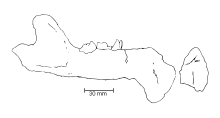Anachlysictis
| Anachlysictis Temporal range: 13–11 Ma | |
|---|---|
 | |
| The holotype lower jaw. | |
| Scientific classification | |
| Kingdom: | Animalia |
| Phylum: | Chordata |
| Class: | Mammalia |
| Infraclass: | Metatheria |
| Order: | †Sparassodonta |
| Family: | †Thylacosmilidae |
| Genus: | †Anachlysisctis |
| Species: | A. gracilis |
| Binomial name | |
| Anachlysictis gracilis Goin, 1997 | |
Anachlysictis gracilis is an extinct carnivorous mammal belonging to the group Sparassodonta, which were metatherians (a group including marsupials and their close relatives) that inhabited South America during the Cenozoic. Unlike other remains assigned to the family Thylacosmilidae (a group of metatherian predators equipped with "saber teeth") that had been found previously, Anachlysictis is the first record of such borhyaenoids in northern South America, and also most primitive and ancient in the family (in fact, is the first confirmed record that did not belong to the genus Thylacosmilus, until the official publication of Patagosmilus in 2010[1]). This species was found in the Villavieja Formation in the area of La Venta in Colombia, a famous fossil deposit in the mid-Miocene (13-11 million years ago), based on fragments that include a front portion of the lower jaw, with an incipient molar tooth and a piece of carnassial from the front of the maxilla.[2]
Anachlysictis, unlike its better known relative, Thylacosmilus, was smaller, weighing around 18 kilograms (~8.16 pounds),[3] and the specialized features of the latter such as the flanges on the lower jaw to adjust the fangs were smaller (due to the upper canines not being as long, in terms of proportions) and lacked the rim of the eye socket, which would give to the skull a flattened profile. Otherwise it can be assumed that their anatomy was generally not as specialized as that of his later relatives, but it had carnassial teeth to process more effectively meat and flat fangs, located just below the nose, without being cross-rounded as in other un-specialized mammal carnivores, while the accommodation area of the masseter muscle (involved in the movements of the jaw) was reduced.[4] This is because, as in other related predatory saber-toothed species, such as Thylacosmilus and the cat Smilodon, this muscle is reduced, leaving more space for the jaw joint to increase its opening angle, which although affecting mandibular power is compensated because they do not need such a large bite force to use their canines because they let the well-developed neck muscles bring down the skull and allow the fangs to cross through the flesh of their prey.
Notably, until its discovery it was supposed that Thylacosmilus was a close relative of the family Borhyaenidae, or even a specialized member of the same, having emerged in the late Miocene; the most primitive characteristics and age of Anachlysictis suggest a previous origins of the thylacosmilids at the base of the superfamily Borhyaenoidea, whose monophyly needs review. In fact, the pattern of the molars of Anachlysictis is very similar to the little-known methatherian Hondadelphys, also from the La Venta that was considered early as a rare species of opossum and now considered a primitive member of the Sparassodonta, so Hondadelphys could well represent the sister clade of Thylacosmilidae.[4]
References
- ↑ Forasiepi A. & Carlini A. A new thylacosmilid (Mammalia, Metatheria, Sparassodonta) from the Miocene of Patagonia, Argentina. Zootaxa 2552: 55–68 (2010)
- ↑ Goin, F. J. (1997). New clues for understanding Neogene marsupial radiations. In: Vertebrate Paleontology in the Neotropics. The Miocene Fauna of La Venta, Colombia, R. F. Kay, R. Cifelli, R. H. Madden, and J. Flynn, eds., pp. 185-204, Smithsonian Institution Press, Washington, DC.
- ↑ Wroe, S., Argot, C., & Dickman, C. (2004). On the rarity of big fierce carnivores and primacy of isolation and area: tracking large mammalian carnivore diversity on two isolated continents. Proceedings of the Royal Society B Biological Sciences, 271(1544), 1203-1211.
- 1 2 Goin, F.J. 2003. Early marsupial radiations in South America. En: M. Jones, C. Dickman y M. Archer (eds.), Predators with Pouches, The Biology of Carnivorous Marsupials, CSIRO Publishing, Australia, pp. 30-42.